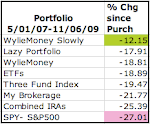At the time, I knew nothing about investing, so I did not know that there were reasonable alternatives that did not entail 5% back end sales loads and absurd expense ratios (all four of these terrible funds have expenses over 1 1/2%).
Here is what I was sold:
$1000 Putnam New Opportunities 28.629 shares PNOBX
$1000 Putnam Global Growth 102.249 shares PEQBX
$4000 Putnam Growth and Income 251.731 shares PGIBX
$2000 Putnam Voyager Fund 139.958 PVOBX
Not only did I pay way more than necessary, I missed out on huge gains that many other mutual funds were racking up. Most other funds in the same categories these 4 funds invest in would have been better options.
Had I held on to those funds, my initial investment would be worth $15,120.25 today. That is not even double my original investment for a diverse portfolio invested in equities for over a decade.
 I'm not going to go on a rant about Putnam. These days you can google Putnam and easily find out how well it is doing.
I'm not going to go on a rant about Putnam. These days you can google Putnam and easily find out how well it is doing.I watched my funds lag their peers during the hot 90's market and on March 3rd, 2000 I sold them and invested in a portfolio of Janus funds.
My timing could not have been worse.
Seriously.
I missed the peak of the dot.com bubble by 3 days.
Here is what I bought:
 That's right- I'm sitting on a 29.70% loss, 8 years later. Maybe I should link to this post instead of my current disclaimer!
That's right- I'm sitting on a 29.70% loss, 8 years later. Maybe I should link to this post instead of my current disclaimer!What upsets me more than that loss, however, is the $@!#@#* who sold me those terrible Putnam Funds.
"Why?" you might ask, "At least with the Putnam Funds, you would have made money."
Yes, I answer, but had I known in 1996, what I knew in 2003, which was not much about economics or timing, but a bit more about low cost no-load funds... and invested my $8000 in 4 roughly equivalent Janus funds from the group of Janus funds I actually bought in 2000...

...I would have more than tripled my investment.
My current approach for non-retirement investing is to invest in no-load, no-fee funds with low expenses that have a long record of doing well in their respective categories compared to their peers and indexes. I pick funds from different fund families when all other things are roughly equal. And I pick funds that allow $100 or lower subsequent investments so I can add to each fund consistently over time.
I have actually held on to JAGIX, JAMRX and JAENX. I traded in JAWWX for JAOSX a while ago. And by adding to those funds, I have made up some ground.

The experience of getting hosed by my bank and then getting wupped by bad timing provided incentive for me to learn more about investing. I'm not sure I have the right formula now, but I feel much better about my approach and am learning more all the time.



4 comments:
When is the right time to invest in mutual funds ?
Your story reminds me of my father. He too was largely self-taught in these matters. But he "studied" his decisions and learned from them. He not only kept records of the choices he made, but of the ones he rejected so he would know if he had chosen well. And over the years he became a smart man in matters financial.
tool, may I refer you to my post called "When to buy mutual funds."
Anonymous, I wish I had a chance to chat with your father about his approach to investing!
Post a Comment